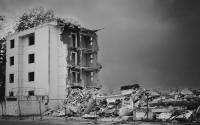Common Dreams / Published on Wednesday, July 23, 2003 by the lndependent/UK
His Sons are Dead but Saddam Lives, as Do Forces of Resistance
So they are dead. Even Baghdad exploded in celebratory, deafening automatic rifle fire at the news, a delight of matchstick-snapping sound and red tracer bullets.
The burned, bullet-splashed villa in Mosul, the four bullet-damaged corpses, America's hopes however vain that the deaths of Saddam Hussein's two sons, Uday and Qusay, will break the guerrilla resistance to Iraq's US occupation troops, all combined last night to give the American occupation of Iraq a seemingly new and invincible power. And a new illusion that they may be safe from further attack. From the start, it looked as if the brothers might be dead. The two dead men were said to bear an impressive resemblance to Uday and Qusay. The house was owned by Mohamed al-Zidani, a tribal ally of the Husseins. A 14-year-old child killed by the Americans one of the four dead might have been one of Saddam's grandsons. Qusay was a leader of the Special Republican Guard, a special target of the Americans.
But it was a bloody battle. Those Iraqis who loved the Saddam regime will at least claim that his sons fought to the death.
The Americans used their so-called Task Force 20 to storm the pseudo-Palladian villa on a main highway through Mosul.
Task Force 20 combines Special Forces and CIA agents. But this is the same Task Force 20 that blasted to death the occupants of a convoy heading for the Syrian border earlier this month, a convoy whose travelers were meant to include Saddam himself and even the two sons supposedly killed yesterday. The victims turned out to be smugglers. And American Intelligence was also responsible for the air raid on a Saddam villa on 20 March, which was supposed to kill Saddam. And the far crueler air raid on the Mansur district of Baghdad at the end of the air bombardment in April, which was supposed to kill Saddam and his sons but only slaughtered 16 innocent civilians.
All proved to be miserable failures. So yesterday's killings will be billed as a historical reversal of fortunes.
But the questions remain. In a family obsessed with good reason with their own personal security, why were Uday and Qusay together? Why did they allow themselves to be trapped, the two so-called "lions of Iraq" (this courtesy of Saddam) in the very same cage?
Saddam's early life was spent on the run after he tried to assassinate an Iraqi prime minister. He dug a bullet out of his body after being shot. But he always traveled alone. In adversity, the family had learnt to stay apart, just as they had during the 1991 Gulf War and during the invasion of Iraq in March.
Even in power, Saddam and his sons were in hiding.
The American military in Mosul were saying last night that the four Iraqi bodies were "pretty shot up" in other words, they had been shot so many times in the face that they had been disfigured and so another question remains: will Iraqis believe that the corpses really are those of those of Saddam's sons?
And will this bring the guerrilla war to an end?
Even though Uday and Qusay are dead, Saddam is clearly still alive. Though Uday was a cruel man and a psychopath, the sons were appendages to the king, mere assistants in the monster's cave. Saddam lives. And his voice is still heard on tape throughout Iraq. It is of his fate that Iraqis are waiting to hear.
Secondly, and far more importantly, there is a fundamental misunderstanding between the American occupation authorities in Iraq and the people whose country they are occupying.
The United States believes that the entire resistance to America's proconsulship of Iraq is composed of "remnants" of Saddam's followers, "dead-enders", "bitter-enders" they have other phrases to describe them.
Their theory is that once the Hussein family is decapitated, the resistance will end.
But the guerrillas who are killing US troops every day are also being attacked by a growing Islamist Sunni movement that never had any love for Saddam. Much more importantly, many Iraqis were reluctant to support the resistance for fear that an end to American occupation would mean the return of the ghastly old dictator.
If he joins his sons in that special nirvana that the Baath keeps for its children a place of marble palaces and torture chambers, I suspect the chances are that the opposition to the American-led occupation will grow rather than diminish, on the basis that, with Saddam gone, Iraqis will have nothing to lose by fighting the American forces.






